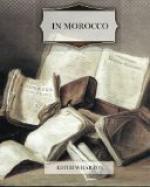These personages, when they ride abroad, are preceded by a swarthy footman, who keeps his hand on the embroidered bridle; and the government officers and dignitaries of the Makhzen[A] are usually escorted by several mounted officers of their household, with a servant to each mule. The cry of the runners scatters the crowd, and even the panniered donkeys and perpetually astonished camels somehow contrive to become two-dimensional while the white procession goes by.
[Footnote A: The Sultan’s government.]
Then the populace closes in again, so quickly and densely that it seems impossible it could ever have been parted, and negro water-carriers, muffled women, beggars streaming with sores, sinewy and greasy “saints,” Soudanese sorcerers hung with amulets made of sardine-boxes and hares’-feet, long-lashed boys of the Chleuh in clean embroidered caftans, Jews in black robes and skull-caps, university students carrying their prayer-carpets, bangled and spangled black women, scrofulous children with gazelle eyes and mangy skulls, and blind men tapping along with linked arms and howling out verses of the Koran, surge together in a mass drawn by irresistible suction to the point where the bazaars converge about the mosques of Moulay Idriss and El Kairouiyin.
Seen from a terrace of the upper town, the long thatched roofing of El Attarine, the central bazaar of Fez, promises fantastic revelations of native life; but the dun-colored crowds moving through its checkered twilight, the lack of carved shop-fronts and gaily adorned coffee-houses, and the absence of the painted coffers and vivid embroideries of Tunis, remind one that Morocco is a melancholy country, and Fez a profoundly melancholy city.
Dust and ashes, dust and ashes, echoes from the gray walls, the mouldering thatch of the souks, the long lamentable song of the blind beggars sitting in rows under the feet of the camels and asses. No young men stroll through the bazaar in bright caftans, with roses and jasmine behind their ears, no pedlars offer lemonade and sweetmeats and golden-fritters, no flower-sellers pursue one with tight bunches of orange-blossom and little pink roses. The well-to-do ride by in white, and the rest of the population goes mournfully in earth-color.
But gradually one falls under the spell of another influence—the influence of the Atlas and the desert. Unknown Africa seems much nearer to Morocco than to the white towns of Tunis and the smiling oases of South Algeria. One feels the nearness of Marrakech at Fez, and at Marrakech that of Timbuctoo.
Fez is sombre, and the bazaars clustered about its holiest sanctuaries form its most sombre quarter. Dusk falls there early, and oil-lanterns twinkle in the merchants’ niches while the clear African daylight still lies on the gardens of upper Fez. This twilight adds to the mystery of the souks, making them, in spite of profane noise and crowding and filth, an impressive approach to the sacred places.




